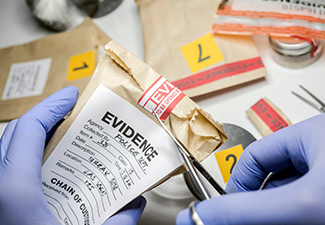Understanding Evidence in a Criminal Trial
Dec. 29, 2022
 You’re being investigated or even charged with a criminal act and face potential prosecution in a court of law. You’ve heard the phrase “beyond a reasonable doubt” when it comes to a jury convicting you based on the evidence submitted. The first question that comes to mind is, “What kind of evidence can they submit?”
You’re being investigated or even charged with a criminal act and face potential prosecution in a court of law. You’ve heard the phrase “beyond a reasonable doubt” when it comes to a jury convicting you based on the evidence submitted. The first question that comes to mind is, “What kind of evidence can they submit?”
Both the federal government and the Commonwealth of Virginia have established rules of evidence that determine which types of evidence can be submitted, and upon which grounds potential evidence can be challenged and even excluded by the defense team or by prosecutors to evidence submitted in your defense.
If you’re facing a criminal charge in or around Charlottesville, contact Bryan J. Jones, LLC. Bryan is an experienced criminal defense attorney who will fight for you and keep you in the loop during the entire process of crafting your defense. He proudly serves clients throughout Albemarle, Louisa, Greene, Orange, Fluvanna, and Nelson counties, Virginia.
What Is Evidence?
Evidence submitted at a trial can come in many forms, including:
Testimony by witnesses
Written testimony
Audio or video recordings or photographs
Physical objects such as clothing or a weapon allegedly used in the crime
Digital data culled from a computer or cellphone or other devices, or even online
Scientific findings such as the results of a blood test
Demonstrative evidence such as charts, illustrations, displays, and the like to shed light on a complicated issue
The Difference Between Direct and Circumstantial Evidence
You have probably heard the term circumstantial evidence. What does it mean?
Direct evidence usually consists of eyewitness testimony, a confession, or scientific evidence.
Circumstantial evidence is used to show from the circumstances that the defendant is more likely guilty and less likely innocent. It is often used to show criminal intent. Typically, proof of someone’s intent is deduced from their actions and conduct.
Circumstantial evidence does not carry any less weight in a judicial sense than direct evidence, but it is up to the jury to decide whether the evidence is enough to convict in the absence of any direct evidence. A defense attorney can counter with the introduction of their own circumstantial evidence that the defendant is more likely innocent than guilty or can argue that the prosecution’s evidence does not point toward guilt but toward innocence.
What Is Relevant Evidence?
If you watch TV or cinema courtroom dramas, you’ll often hear a defense attorney shouting, “Objection, that evidence is irrelevant.” So, what does it mean for evidence to be relevant? Relevant evidence is evidence that has a tendency to make the existence of any fact that is of consequence to the determination of the trial more probable.
The term “probative value” is also used when weighing the relevance and/or admissibility of any evidence. Probative value means it helps prove the facts under trial – that is, it shows something to be more probable than not.
When Evidence Becomes Inadmissible
Generally, evidence that has probative value will be admissible in court, but there are exceptions if evidence results in “unfair prejudice, confusing the issues, misleading the jury, undue delay, wasting time, or needlessly presenting cumulative evidence,” according to the Federal Rules of Evidence.
Other examples of evidence that is inadmissible include:
Improperly obtained evidence: Improperly obtained means authorities violated the defendant’s civil rights when obtaining the evidence. An example is an evidence obtained from a person’s home without a proper search warrant.
Evidence that is more prejudicial than probative: This involves a judgment by the court on whether the probative value of any evidence outweighs any prejudice it may cause in the deliberative and jury process. For instance, a piece of evidence that serves only to highlight the poor character of the defendant but does not provide valuable insight into the case at hand can be deemed inadmissible.
Evidence that is not relevant: As discussed above, the evidence must be relevant, meaning it has bearing on the facts of the case.
Evidence that is hearsay: Hearsay is a statement garnered from outside the courtroom that is being introduced as evidence. An example would be someone who heard from someone else that the defendant committed the crime they are being charged with. Since there is no way to judge whether the statement is reliable, it is inadmissible. However, statements made out of court by the defendant are admissible.
The Exclusionary Rule
Evidence submitted in violation of the defendant’s constitutional rights can be challenged and suppressed through what is known as the Exclusionary Rule. The example of illegal searches and seizures (no warrant, for instance) has already been given, which represents a violation of the Fourth Amendment.
Violations of the Fifth Amendment, the right against self-incrimination, and the Sixth Amendment, the right to an attorney in a criminal case, also fall under the Exclusionary Rule. Evidence submitted in violation of constitutional rights is termed as “fruit of the poisonous tree.”
Skilled and Aggressive Representation
If you find yourself being investigated or charged with a crime in Charlottesville, Virginia, you need to move quickly to obtain legal representation that will work with you to develop a strong and focused defensive strategy. That defense attorney can be found at the law office of Bryan J. Jones, LLC.
Reach out immediately, so our legal team can work with you to fight for the best result possible.does itfdsa